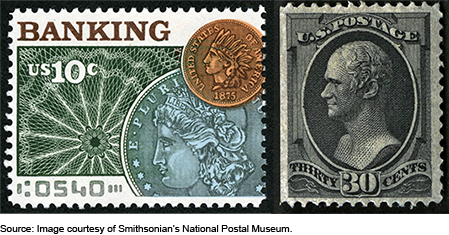Prior to 1876, there was fierce competition among engraving firms and private bank note companies for contracts to print U.S. Treasury bank notes. Then, in 1877, congressional legislation established the Bureau of Engraving and Printing (BEP) as the exclusive printer of U.S. government currency.
So, the engraving firms shifted their focus to another source of
revenue—postage stamps. U.S. postage stamps from the 1860s to the 1890s were known as “bank notes” because they were printed by the National Bank Note Company (which held the contract from 1861-72), the Continental Bank Note Company (contracted for 1873-78), and the American Bank Note Company (contracted for 1879-93). But in 1894, the BEP won the postage stamp printing contract as well, and it continued in this role for 111 years. Many of the stamps that the BEP would produce during that time commemorated important people and events in American history, including individuals related to banking and finance.
The thirty-cent Alexander Hamilton was the first stamp to depict a Secretary of the Treasury. Other secretaries of the Treasury honored with stamps include Albert Gallatin and Andrew Mellon.
According to the National Postal Museum, the ten-cent Banking and Commerce commemorative stamps, which first went on sale in New York on October 6, 1975, highlighted “the important role that banking and commerce played in the development of the United States.”
The Post Office issued a completely different product—postal savings stamps—between 1911 and 1941 to give people who distrusted banks another means of depositing money. Denominations ranged from ten cents to five dollars. The stamps could be redeemed as credit in postal savings accounts, accruing interest at 2 percent per year (1 percent in New Jersey because of state banking rules, according to a March 1944 article in the Wall Street Journal). The postal savings stamps, along with savings stamps and war savings stamps, were a hit, possibly because Post Office branches, where the postal savings offices were located, were open for longer hours than banks. Savings reached $1.2 billion during the 1930s, and a report published by the Federal Reserve Board of Governors in 1937 showed that while the number of active banks had dropped by more than 50 percent between 1924 and 1933, the number of postal savings offices increased by 18 percent (see Table 3, page 17, of the report). Postal savings hit a high in 1947, at roughly $3.4 billion.
In 1937, the American Bankers Association (ABA) complained to Congress that the postal savings system was in direct competition with private banks. Any animosity between the ABA and the Post Office was eventually forgotten: a three-cent stamp was issued on January 3, 1950, to mark the 75th anniversary of the ABA.
After World War II, the interest rates offered by banks and U.S. savings bonds were equal to or higher than those offered by the Postal Savings System, leading deposits to drop to $416 million by 1964. The Post Office discontinued the savings accounts system in 1966. In recent years, the idea of the Post Office as a financial services provider has resurfaced.
Disclaimer
The views expressed in this post are those of the author and do not necessarily reflect the position of the Federal Reserve Bank of New York or the Federal Reserve System. Any errors or omissions are the responsibility of the author.

Mary Tao is a research librarian in the Federal Reserve Bank of New York’s Research and Statistics Group.











 RSS Feed
RSS Feed Follow Liberty Street Economics
Follow Liberty Street Economics